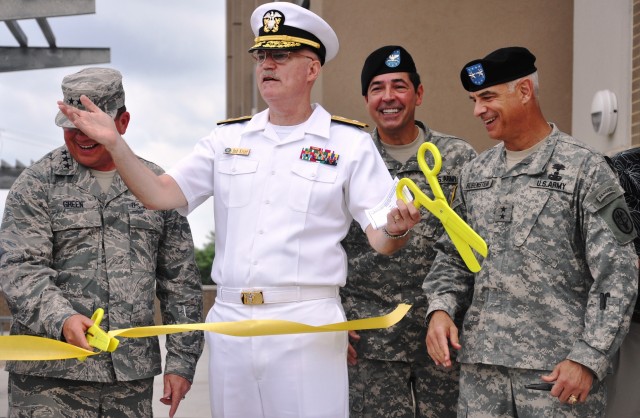
FORT SAM HOUSTON, Texas -- The future of military medical training arrived at Fort Sam Houston in a big way June 30 with the opening of the sprawling Medical Education and Training Campus.
The METC, the crown jewel of the 2005 Base Realignment and Closure Commission's mandates for Fort Sam Houston, is an integrated campus under a single university-style administration, with more than 100 courses being taught there.
Rear Adm. William R. Kiser is the METC's first commandant, with Army Col. Larry Hanson as deputy commandant and dean. Air Force Command Chief Master Sgt. Kevin Lambing is the senior enlisted adviser.
"Today marks a significant milestone in the ongoing story of military medicine," Kiser said. "Everywhere our nation sends our finest to serve, our graduates will be there with them serving as a force for good because of the work done here."
Making history as the world's largest military medical and training institution, METC entered into its initial operating capability with a ribbon-cutting ceremony in June. The first course, Radiography Specialist, actually began in April. Other courses will be phased in during the summer and fall.
"METC will serve as the birthplace for joint interoperability for corpsman, medics and technicians," said Lambing in his remarks. "The souls that will walk the hallowed halls of this institution will make a difference in faraway lands for centuries to come. In five years, every medic and corpsman under the grade of E-5 will have been educated here at METC."
The campus will have more than 24,500 students going through its doors each year, with an average daily student load of approximately 8,000. METC will also employ an operating staff and faculty of more than 1,400.
By service, student breakdown includes approximately 45 percent Army, 31 percent Navy and 24 percent Air Force. The longest program offered is cytology - which is the study of cells - at 52 weeks; and the shortest, at four weeks, is patient administration.
"Today is truly about new beginnings. METC's mission is to produce the world's best military healthcare personnel to support the nation and the vision is to be the nation's leader in military medical education and training," said Rear Adm. Eleanor Valentin, commander, Navy Medicine Support Command and chair, METC Flag Officers Steering Committee. "This mission and vision guided us to ensure METC provides curriculum and education that preserves each service's identity while creating an environment where our enlisted professionals can learn from their counterparts in their sister services."
Consolidated basic and specialty enlisted training from five separate service medical learning centers have already moved or are in the process of moving to San Antonio. These include the 882nd Training Group from Sheppard Air Force Base in Wichita Falls, Texas (at Camp Bullis as of June 25); the Naval School of Health Sciences at Portsmouth, Va.; the Naval School of Health Sciences in San Diego; and the Naval Hospital Corps School in Great Lakes, Ill.
Enlisted medical training mission at Walter Reed Army Medical Center in Washington, D.C., will also transfer to METC.
The AMEDDC&S will shift 41 enlisted programs to METC but continue to keep nearly 200 programs and more than half its full-time staff. METC will do entry-level medic training, while AMEDDC&S will continue advanced enlisted medical training, as well as officer and advanced NCO courses.
"METC is more than an institution of higher learning," said Lambing, who was most recently the Air Education and Training Command chief of the enlisted medical force. "This will become a platform of medical diplomacy on the world stage. Nations across the globe will send their men and women to this campus because METC stands for the best platform the world has even known for producing medics and corpsmen."
METC's footprint covers more than two million square feet on Fort Sam Houston and cost more than $1.2 billion to build and equip. Each of its three current dormitories will house 1,200 Airmen and Sailors. Two other dorms will be built nearby for Army students, with one housing 1,200 Soldiers and the other 600 Army students.
"I want you to see not just the bricks and stones and mortar and glass, I want you to see the people whose lives will be made better by what transpires in these buildings," Kiser said. "These buildings are an investment in the health and safety of the men and women who go into harm's way. They are an investment for what we in military medicine stand for.
"We will show it is possible to value our heritage and distinctions and still work together towards a common vision," Kiser said. "Our vision and commitment at METC can be summed up in a single sentence: We will provide America's uniformed services the finest medics, the finest techs, the finest hospital corpsmen who are well-trained, capable and ready to support the missions of our country anywhere around the globe."

Social Sharing